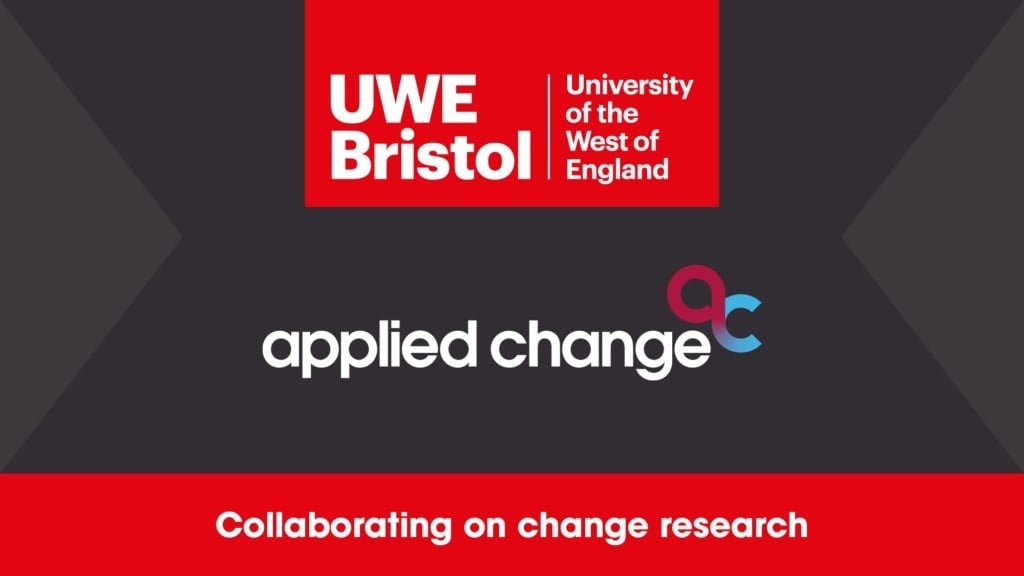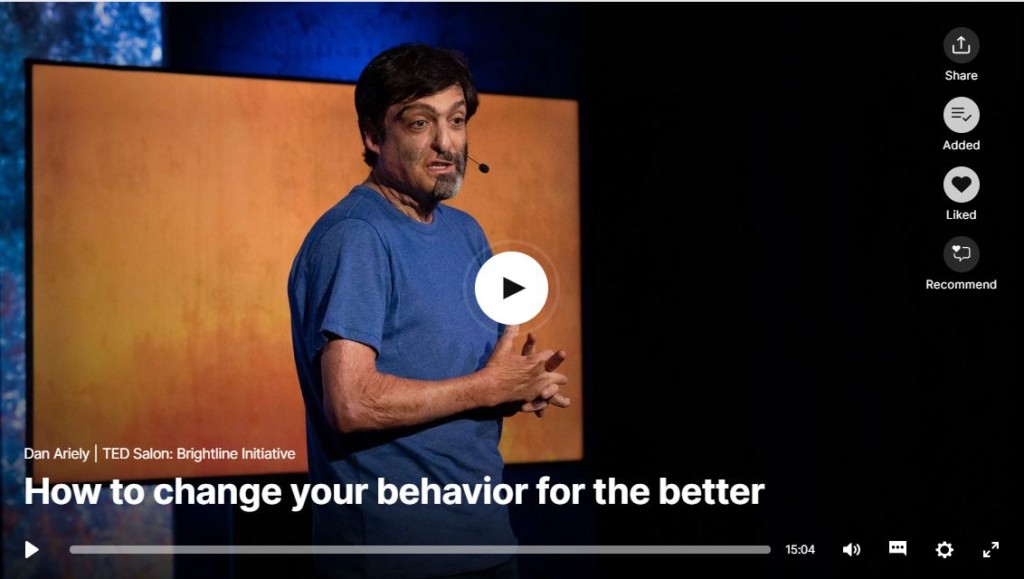UWE Research Study: Measuring and Reducing Change Resistance in Organisations
By Mark Vincent
Share

What is it that causes us to resist change? This research study, conducted with our help by Psychology Masters’ student Katherine Reader at UWE, explores the key factors and predictors of change resistance and suggests how they can be measured with a view to reducing their effect. A free copy of the full research paper is also available – the details of how to get it are at the end of the article.
………………….
For businesses to survive and achieve greater success, it is necessary for them to embrace change and adapt to new conditions. This is even more poignant in light of technological progression and increased globalisation. Since the start of the COVID-19 pandemic, the need for employees and companies to adapt to changing conditions through flexibility has further highlighted the necessity of embracing, rather than resisting, change.
What is change resistance?
Resistance to change can be defined as either an obstacle, incomplete transition, or force that stops the movement of change (Bridges, 1986; Kotter, 1995; Maurer, 1996). Change resistance occurs when individuals or organisations oppose or struggle against different and new concepts that they are not comfortable with. Resistance to business change can simply occur in a single individual employee, several employees or within the structure of the organisation itself.
Change resistance can occur both actively and passively. That is to say that individuals or organisations can purposely resist the changes in order to ensure the change fails or the opposing behaviours can be covert and subtle, facilitating failure in the change. Passive resistance is less obvious and therefore more tricky to identify and address directly.
Change resistance can arise at all levels throughout the change implementation process. With regard to the organisation and the culture of the company, if the desired change is incompatible with the ethos and values held by the organisation, there is likely to be widespread resistance to the change. At an organisational and societal level, these attitudes can also impact the attitudes and behaviours of individual employees and can influence their resistance to or compliance with change.
Identifying change resistance
Occupational psychologists have designed numerous tools and scales to help organisations identify employee readiness for change. We’ll discuss a few of the key tools here.
An early readiness for change scale (Cunningham at al., 2002) consisted of 6 items spread across 5 ‘stages’ of change:
- Pre-contemplative
- Contemplative
- Preparatory
- Action
- Maintenance
It focuses on understanding how psychologically ready and willing employees are to get on board with the change. At one end they may be absolutely opposed to it or they may be considering it or further along the scale they have fully embraced it.
Building on this idea and more widely tested is the Readiness for Organisational Change (ROC) Scale. This scale starts to go deeper by measuring how individuals perceive the change as a key contributor to their readiness for change. It focuses on 4 key factors as a predictor of their level of engagement and therefore the likelihood of success of the change:
- Appropriateness – whether the individual feels the change is appropriate/needed,
- Management Support – do they feel they have management support throughout the change process?
- Change Efficacy – is the change going to be effective for the organisation?
- Personally Beneficial – does this change benefit them as an individual e.g. does a restructuring of teams in the organisation mean they will lose their close working relationships with certain colleagues? If so, they might resist the change.
One known limitation of these scales is that they don’t specifically take into account the specific attitudes of individual employees to change and the effect of those attitudes on the way in which they are likely to respond.
They are at least useful though for identifying employee beliefs towards the change and the level of their engagement with it, albeit without exploring too deeply the underlying individual factors. Importantly, they do at least highlight the role that the belief systems of employees play within change success, which is a good place to start.
Attitudes, beliefs and organisational change
According to early behavioural studies, there are specific beliefs that could influence individuals’ attitudes towards change. Attitudes can cause three explicit ‘reactions’ to change: affective (emotional), cognitive (thoughts) and behavioural (covert or overt).
These attitudes included a discrepancy between information and values, the appropriateness of the change, the efficacy of the change and principal support for the change. Attitudes regarding change were also heavily influenced by the extent to which the organisation accounted for the employees’ needs, values, goals, motivations and preferences during the implementation process of change.
Later research found that as well as negative resistance to change, some employees had an ambivalence regarding change on several levels, including a subconscious and behavioural level, which leads to both psychological and overt behavioural resistance. This can mean that an employee may feel an emotional reaction against change, such as anger, anxiety and frustration. They may hold a resistant belief system against change in general and consequently respond in a negative manner towards the proposed changes.
The outlook is not solely negative, of course, because there is scope for employees to embrace change and feel such positive emotions as hope and excitement. It is also possible for a mix of trepidation and excitement to be present in a single employee, which can contribute towards ambivalence.
The way that employees process their emotions and the subsequent behaviours they display is deeply complex because it can be influenced by their working conditions, personal situations and the treatment they receive from the organisation. It is important to gauge whether there is uncertainty, dissatisfaction or change resistance among employees in order to address and rectify it. Furthermore, if the change is so fundamental that it can impact the overall identity of an employee, they are likely to resist it. Without a solution, there is a higher chance that change implementation will be unsuccessful.
Why do organisational change initiatives fail?
Both researchers and practitioners agree that a majority of organisational change initiatives fail, with employees’ resistance to change identified as the predominant reason for these failures. Consequently, it is necessary for there to be positive employee attitudes to organisational change if a change is to succeed. However, change resistance can occur at every level within an organisation and can be implicit within the structure and attitudes of the organisation itself, which can also contribute to a lack of change success.
It’s worth keeping in mind that change resistance might also have some positive influence on successful change processes. This is because negative attitudes toward a specific change can be a tool for learning the change process in the future.
When there is forced change implementation, despite knowledge of resistance, there can be negative consequences for the employees, such as reduced psychological well-being and insomnia, which can directly impact the success of the business. If there is uncertainty for the employees surrounding the change, it can lead to lower job satisfaction and higher staff turnover.
Overcoming change resistance
Successful organisational change requires a mind-set shift. Using the McKinsey 7s framework as a guide, traditional approaches have typically focused almost exclusively on Strategy, Structure and Systems. True success in organisational change comes from also bringing great focus to the other elements: Shared Values, Skills, Staffing and Style. Addressing negative attitudes and behaviours among employees is therefore critical to minimising organisational resistance to change at the organisational level.
There can be a variety of differences in behavioural reactions to change which are directly influenced by an individual employee’s attitudes towards change. Such behaviours can include employee involvement, coping behaviours and behavioural intentions to resist or support change.
Given that implementing organisational changes is profoundly difficult if employees are resistant to these changes, creating a more positive attitude within the staff is the fundamental key to successfully implementing change and change management. Focusing on the way employees perceive change, their psychological well-being, and their clarity and involvement with the change process can not only help make the change process more successful but can positively influence staff happiness, reduce turnover and be beneficial for the organisation in the longer term.
When there is a valid and reliable way to assess the attitudes and behaviours of employees within an organisation in regard to change and resistance to change, this can potentially help. It allows managers, consultants and other professionals to identify how to prioritise resources during the change process. Crucially, practitioner experiences must be incorporated into the review.
As it is clear that change resistance can have negative consequences for the success of organisational change initiatives, it is important to identify what can cause this resistance and address these issues in order to promote successful change implementation. Employees are intrinsic and vital to organisations and so identifying and augmenting their explicit reactions, attitudes and beliefs towards change are fundamental for a change initiative to be successful.
How management can affect change success
There are several influences that both managers and the organisation itself can have on change success or resistance. This includes leadership behaviour in response to the change and whether the organisation implements the change in a way that can coax the employees on board. Open communication from a leadership level as well as encouraging change can help motivate a culture change within the business.
It can also be important for the organisation to focus on how the individual perceives the change within the organisation, how crucial it is to the business, and the projected vision for the future. Without sufficient knowledge of the change, communication, and enticement to share the organisation’s vision for change, employees tend to be less flexible and adaptable and prefer to remain in the status quo rather than embracing any changes. They may associate negative emotions with the change, such as stress and frustration. This change resistance can have a negative effect on the fundamental tenets of the change itself, leading to failure.
Conversely, giving employees information, support and security around the change may result in lowered resistance in response to those crucial factors. Positive emotions and behaviours are more likely to be elicited, including patience, resilience and comfort.
Considerations for the future
Currently, there are a limited number of tools available to predict change resistance within employees in an organisation. We do know, however, that there are clear behavioural predictors and extensive research which can be used very effectively to encourage employees to embrace change rather than resist it.
We also know from the research that the more employees embrace change the quicker the pace of change and the better the outcome for the organisation. And if that isn’t enough there is also clear evidence of increased employee wellbeing throughout the change process, so everybody wins.
Given the pace and nature of change we’re increasingly facing, this must surely be cause for optimism.
Click here for a free download of the full research paper.
Many thanks to Katherine Reader and our friends in the UWE Psychological Sciences team for an excellent piece of research, identifying factors which we believe will become critical as we navigate increasingly transformational change in the years to come.
Get in touch
If you’re starting a change, or already on the journey and need some support, we can help.
Whether it’s coaching or mentoring your leadership team, diagnosing low engagement or leading a change on your behalf, we have a range of options to suit different situations and budgets. Contact us by clicking the button to find out more.
Related content
Why most change happens too slowly, and what to do about it
Is the retail sector teaching us a valuable lesson? Why are previously successful businesses failing to keep the initiative? And what can other sectors learn?
Dan Ariely: How to Change Your Behaviour for the Better
Why do our behaviours so often fail to live up to our good intentions? Some great tips and ideas to consider when making changes not only for ourselves but in those around us.
Derek Sivers: How to start a movement
In this excellent and funny TED short TED video Derek Sivers shows how a movement can be created. Worth keeping in mind when we’re trying to energise a change and it helps to explain how one person can trigger a global phenomenon. Whenever we think we’re too small or insignificant to make a change, it’s also worth remembering there are plenty of historical examples to inspire us such as Rosa Parks, Mahatma Ghandi, Nelson Mandela and, more recently, Greta Thunberg to name just a few.
How to ensure your business changes stay airborne
With the end of the year in sight, many organisations are resolving to make big changes in the coming year, especially given the uncertainty around topics such as the energy crisis and uncertainty in the global markets. At the same time staff retention is becoming a hot topic for many. So how change is delivered is becoming ever more critical.
Unlocking the Brain’s Trust: The Critical Role of Congruence in Business Transformation
Discover why incongruence is the silent saboteur of employee engagement and business transformation. From neuroscience to practical tips, learn how to foster a culture of congruency that builds trust and drives success.
A New Direction – Challenging the Misconceptions About Change
It is possible to make changes quickly without causing workplace stress and attrition but it takes a very different approach…







